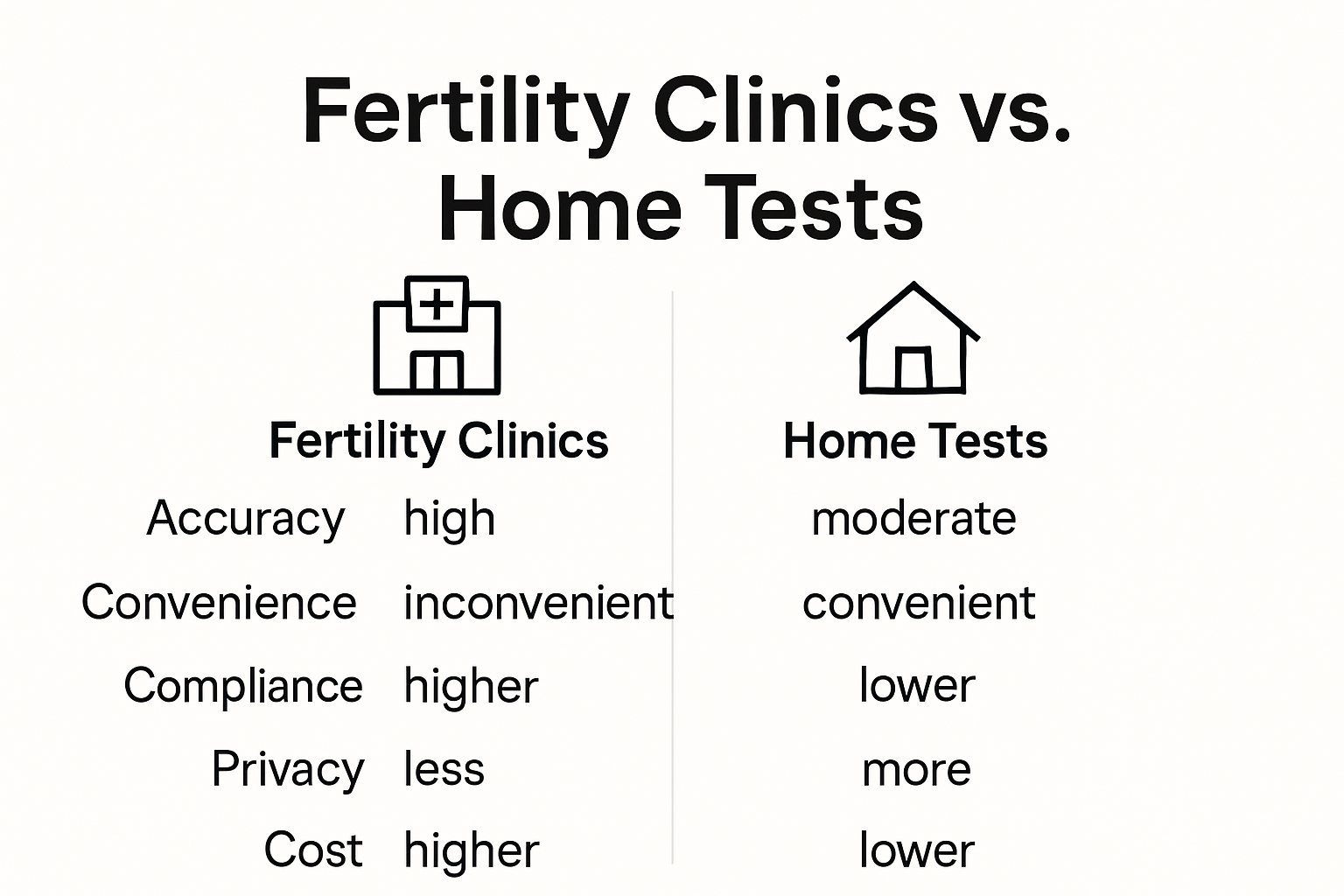After getting a vasectomy, most men wonder how to confirm everything worked as planned. Here’s something you probably didn’t expect. Home fertility test kits now have a 90 percent completion rate among more than 5,000 users, rivaling clinic visits for accuracy and reliability. But the real surprise? At-home tests are not just catching up to clinics—they’re changing the rules of privacy, comfort, and control in ways that could make men rethink old habits.
Table of Contents
- Comparing Accuracy: Clinic Vs Home Fertility Tests
- Laboratory Precision And Reliability
- Compliance And Convenience Factors
- Technological Validation And Accuracy
- Benefits For Men After Vasectomy And Their Partners
- Sexual Health And Relationship Dynamics
- Long-Term Health And Family Planning
- Psychological And Emotional Benefits
- Convenience, Privacy, And Cost Considerations
- Privacy And Discretion
- Cost-Effectiveness And Accessibility
- Compliance And Long-Term Convenience
- When Should You See A Urologist Or Fertility Clinic?
- Critical Post-Vasectomy Follow-Up Indicators
- Medical Red Flags Requiring Immediate Urological Consultation
- Strategic Timing For Professional Assessment
Quick Summary
| Takeaway | Explanation |
|---|---|
| Accurate Testing Options Available | Both fertility clinics and modern at-home tests provide accurate post-vasectomy fertility assessments, with home tests now utilizing CLIA-certified laboratory analysis. |
| Convenience and Compliance Are Key | At-home testing enhances patient compliance by allowing discreet and convenient sample collection, leading to higher completion rates for post-vasectomy monitoring. |
| Proactive Health Management | Vasectomy offers numerous physical, psychological, and relational benefits, including improved sexual satisfaction and reduced stress surrounding unplanned pregnancies. |
| Know When to Seek Professional Help | Symptoms like persistent pain or signs of infection post-vasectomy warrant immediate consultation with a urologist, ensuring comprehensive reproductive health management. |
Comparing Accuracy: Clinic vs Home Fertility Tests
When it comes to post-vasectomy fertility testing, men face a critical decision between traditional fertility clinics and modern at-home testing solutions. Accuracy becomes the paramount concern for anyone seeking definitive confirmation of their reproductive status.

Laboratory Precision and Reliability
Professional fertility clinics have long been considered the gold standard for semen analysis. These facilities employ highly trained technicians and utilize advanced microscopic equipment to perform comprehensive sperm evaluations. Research from The Journal of Urology revealed that while home testing methods are emerging, clinical laboratories still maintain the highest level of diagnostic precision.
At-home fertility tests have made significant technological strides in recent years. A systematic review in the American Journal of Obstetrics & Gynecology concluded that home semen collection methods produce results comparable to in-clinic assessments. This finding suggests that modern home testing kits can provide reliable data without compromising accuracy.
Compliance and Convenience Factors
One critical advantage of home testing emerges in patient compliance. Urological research demonstrated that mail-in semen analysis kits significantly improved long-term testing compliance. At 18 weeks post-vasectomy, compliance rates reached 69%, escalating to 82% by 40 weeks. This substantial improvement indicates that convenience plays a crucial role in ensuring men complete their post-vasectomy fertility monitoring.
Traditional fertility clinics often present logistical challenges. Scheduling appointments, taking time off work, and navigating potentially uncomfortable in-person interactions can discourage men from completing necessary fertility tests. In contrast, at-home testing offers a discreet, streamlined alternative that empowers individuals to take control of their reproductive health.
Technological Validation and Accuracy
Modern at-home fertility tests now utilize CLIA-certified laboratory analysis, which means they meet the same rigorous standards as clinical testing facilities. These advanced kits provide comprehensive sperm count, motility, and concentration assessments. Learn more about our detailed fertility test kit components to understand the scientific precision behind home testing.
While clinic-based testing remains highly accurate, home tests have narrowed the technological gap. The key is selecting a reputable service that employs certified laboratory protocols and provides clear, physician-reviewed results. Men should look for tests that offer transparent reporting, secure result delivery, and comprehensive sperm analysis comparable to clinical standards.
Ultimately, the choice between fertility clinics and home tests depends on individual preferences, comfort levels, and specific medical considerations. Both methods can provide accurate post-vasectomy confirmation when conducted properly. The critical factor is completing the necessary testing to ensure reproductive certainty and peace of mind.

To help clarify the differences between fertility clinic and home fertility testing after vasectomy, here’s a table summarizing their key features:
| Feature | Fertility Clinic Testing | At-Home Fertility Test Kits |
|---|---|---|
| Accuracy | Gold standard; highly precise | Nearly equivalent with CLIA lab analysis |
| Compliance Rate | Lower (e.g., 69% at 18 weeks) | Higher (up to 90% completion) |
| Convenience | Requires appointments, travel, time off | Collect sample at home, mail-in |
| Privacy | Limited; in-person visits | High; private and discreet |
| Cost | Variable (consultations, lab fees) | Transparent, typically all-inclusive |
| Speed of Results | Depends on clinic processing times | Usually fast once received by lab |
| Physician Oversight | Direct, with in-person consultation | Online/remote review and reporting |
Benefits for Men After Vasectomy and Their Partners
Vasectomy represents a significant reproductive health decision that offers substantial benefits for men and their partners. Understanding these advantages goes beyond the medical procedure itself and encompasses physical, emotional, and relational dimensions.
Sexual Health and Relationship Dynamics
Contrary to common misconceptions, vasectomy does not compromise sexual performance or satisfaction. Research published in a comprehensive medical study revealed that sterilized men actually reported improved sexual satisfaction, while their partners’ sexual experiences remained consistently positive. This finding challenges long-standing myths about vasectomy’s impact on intimate relationships.
The procedure eliminates the anxiety surrounding potential unplanned pregnancies, which can significantly reduce stress and enhance sexual spontaneity. Partners can enjoy increased intimacy without the constant concern of contraceptive failures or additional pregnancy risks. Learn more about how vasectomy impacts sexual health to understand the comprehensive benefits for couples.
Long-Term Health and Family Planning
Vasectomy offers a permanent and highly effective contraception method with minimal medical risks. A randomized trial demonstrated that home-collected semen samples were equivalent to clinic-collected samples in terms of sperm quality, highlighting the procedure’s reliability and flexibility. This finding suggests that men can comfortably manage their reproductive health with modern testing approaches.
For couples who have completed their family planning or decided against having children, vasectomy provides a straightforward, low-risk solution. The procedure is typically less invasive and more cost-effective compared to female sterilization methods. Additionally, it eliminates the ongoing expenses and potential side effects associated with hormonal birth control methods.
Psychological and Emotional Benefits
Beyond physical advantages, vasectomy can contribute significantly to men’s psychological well-being. The procedure represents a proactive approach to reproductive health and family planning. By taking responsibility for contraception, men can demonstrate commitment to their partners and shared family goals.
The post-vasectomy recovery timeline is relatively short, with most men returning to normal activities within a week. This quick recovery minimizes disruption to daily life and reduces anxiety associated with surgical procedures.
Clinical research consistently shows that couples who choose vasectomy often report increased relationship satisfaction. The shared decision-making process and mutual understanding about family planning can strengthen emotional connections. Moreover, removing the burden of alternative contraception methods can reduce stress and improve overall relationship dynamics.
It is crucial to approach vasectomy as a collaborative decision between partners. Open communication, mutual understanding, and comprehensive information are key to ensuring both individuals feel comfortable and confident in their choice. Regular post-procedure testing and follow-up consultations help maintain reproductive health and provide peace of mind for both partners.
Here’s a table summarizing the main benefits of vasectomy for men and their partners highlighted in this section:
| Benefit Category | Advantages Discussed |
|---|---|
| Sexual Health | Improved satisfaction, reduced anxiety over pregnancy, enhanced spontaneity |
| Relationship Dynamics | Stronger communication, increased intimacy, shared family planning decisions |
| Long-Term Health | Permanent contraception, less invasive and costly than female sterilization |
| Psychological/Emotional | Reduced stress, positive impact on well-being, quick recovery |
Convenience, Privacy, and Cost Considerations
Choosing between fertility clinics and home testing involves more than just medical accuracy. Men must carefully evaluate the practical aspects of convenience, privacy, and financial implications when selecting their post-vasectomy fertility testing method.
Privacy and Discretion
Privacy remains a paramount concern for men undergoing fertility testing. Home testing kits offer an unprecedented level of personal discretion that traditional clinic-based methods cannot match. Research published in fertility studies demonstrates that home-based semen analysis can effectively address patient concerns about confidentiality and personal comfort.
Traditional fertility clinics often require multiple in-person visits, exposing individuals to potentially uncomfortable social interactions. In contrast, at-home testing eliminates these awkward encounters. Men can collect samples in the privacy of their own space, avoiding waiting rooms and potentially embarrassing medical consultations. Explore our guide on maintaining privacy during fertility testing to understand the discrete nature of modern testing approaches.
Cost-Effectiveness and Accessibility
Financial considerations play a significant role in testing decisions. Comprehensive research revealed that mail-in semen analysis services can break down traditional barriers related to race, education, and income. By achieving a remarkable 90% completion rate among 5,414 patients, these services demonstrate their potential to democratize access to fertility testing.
Traditional clinic-based testing often involves multiple expenses: consultation fees, laboratory charges, and potential time off work. Home testing kits typically offer a more transparent and predictable pricing structure. The all-inclusive nature of these kits means no hidden costs or unexpected additional charges. Men can budget precisely for their fertility testing needs without financial surprises.
Compliance and Long-Term Convenience
While convenience is crucial, testing compliance remains equally important. A detailed study examining post-vasectomy semen analysis methods found no significant difference in compliance rates between home-based (59.6%) and in-office (58.8%) testing methods. However, the ease of home testing can potentially encourage more men to complete their necessary follow-up assessments.
The modern approach to fertility testing recognizes that convenience extends beyond simple collection methods. Secure online result delivery, quick turnaround times, and physician-reviewed reports make home testing an attractive option for men seeking efficient and comprehensive reproductive health monitoring.
Ultimately, the choice between fertility clinics and home tests depends on individual preferences, comfort levels, and specific personal circumstances. Both methods offer legitimate paths to understanding post-vasectomy fertility status. The key is selecting an approach that provides accurate results while meeting individual needs for privacy, affordability, and convenience.
When Should You See a Urologist or Fertility Clinic?
Navigating post-vasectomy care requires understanding the precise moments when professional medical consultation becomes necessary. While home testing offers remarkable convenience, certain scenarios demand direct urological expertise and intervention.
Critical Post-Vasectomy Follow-Up Indicators
The American Urological Association recommends specific timelines and protocols for post-vasectomy follow-up. Most healthcare professionals require semen testing approximately three months after the surgical procedure to confirm complete sterility. During this period, alternative contraception remains crucial, as residual sperm can remain in the reproductive tract.
The Urology Care Foundation emphasizes that a vasectomy doesn’t achieve immediate sterility. Sperm will still exist in the reproductive pipeline, necessitating comprehensive testing to ensure complete clearance. This nuanced understanding highlights why professional consultation remains essential, even with advanced home testing capabilities.
Medical Red Flags Requiring Immediate Urological Consultation
Certain symptoms and conditions warrant immediate urological intervention. Persistent pain lasting beyond two weeks, signs of infection such as fever or significant swelling, and unusual discharge are critical indicators that professional medical assessment is required. Check out our comprehensive guide on semen testing insights to understand potential warning signs.
Additionally, men experiencing prolonged discomfort, unusual testicular changes, or complications during the recovery process should schedule a professional consultation. Home tests cannot replace a thorough physical examination and professional medical expertise when complex symptoms emerge.
Strategic Timing for Professional Assessment
The Mayo Clinic recommends specific strategic windows for professional follow-up. Most urologists suggest initial consultation approximately six to eight weeks post-procedure, followed by comprehensive semen analysis around three months. This timeline allows for proper healing and accurate assessment of reproductive status.
Home testing serves as an excellent preliminary screening tool, but it should not completely replace professional medical oversight. Men should view home tests as a complementary approach to, not a complete substitute for, urological consultation. Strategic planning involves using home testing to monitor progress while maintaining scheduled professional assessments.
Ultimately, individual medical history, personal health factors, and specific post-surgical recovery play significant roles in determining the optimal approach. While home testing provides unprecedented convenience and initial insights, professional medical guidance remains an irreplaceable component of comprehensive reproductive health management. The key is balancing technological convenience with professional medical expertise to ensure optimal health outcomes.
Frequently Asked Questions
What is the best way to confirm sterility after a vasectomy?
The best ways to confirm sterility after a vasectomy are through semen analysis at fertility clinics or using modern at-home fertility test kits. Both methods can provide accurate results, with home tests now achieving a 90% completion rate among users.
How accurate are home fertility test kits compared to fertility clinics?
Home fertility test kits have become highly accurate and now use CLIA-certified laboratory analysis, which makes their results comparable to those obtained at fertility clinics. Recent research shows that home tests can produce reliable data without compromising accuracy.
When should I see a urologist after my vasectomy?
You should see a urologist if you experience persistent pain beyond two weeks, signs of infection such as fever or swelling, or any unusual discharge. Additionally, following up with a urologist approximately three months after the procedure is recommended to confirm complete sterility.
What are the benefits of using a home fertility test after a vasectomy?
Using a home fertility test offers several benefits, including privacy, convenience, and cost-effectiveness. Home tests allow for discreet sample collection and higher compliance rates due to the ease of use, empowering men to take control of their reproductive health.
Recommended
- Fertility Test Kit Benefits: Accurate Results for Vasectomy & Concepti
- Home Testing vs Clinical Testing for Vasectomy Confirmation 2025
- Why Semen Testing Is Critical: Insights for Men and Clinics
- Why Test Semen Sample: Answers for Vasectomy & Fertility 2025
- Fertility Test Kit Components: Guide for Vasectomy and Couples
- Semen Analysis and Fertility Planning: Insights for Vasectomy and Conc





